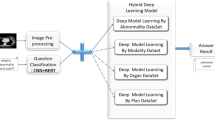Abstract
Purpose
AI-image interpretation, through convolutional neural networks, shows increasing capability within radiology. These models have achieved impressive performance in specific tasks within controlled settings, but possess inherent limitations, such as the inability to consider clinical context. We assess the ability of large language models (LLMs) within the context of radiology specialty exams to determine whether they can evaluate relevant clinical information.
Methods
A database of questions was created with official sample, author written, and textbook questions based on the Royal College of Radiology (United Kingdom) FRCR 2A and American Board of Radiology (ABR) Certifying examinations. The questions were input into the Generative Pretrained Transformer (GPT) versions 3 and 4, with prompting to answer the questions.
Results
One thousand seventy-two questions were evaluated by GPT-3 and GPT-4. 495 (46.2%) were for the FRCR 2A and 577 (53.8%) were for the ABR exam. There were 890 single best answers (SBA), and 182 true/false questions. GPT-4 was correct in 629/890 (70.7%) SBA and 151/182 (83.0%) true/false questions. There was no degradation on author written questions. GPT-4 performed significantly better than GPT-3 which selected the correct answer in 282/890 (31.7%) SBA and 111/182 (61.0%) true/false questions. Performance of GPT-4 was similar across both examinations for all categories of question.
Conclusion
The newest generation of LLMs, GPT-4, demonstrates high capability in answering radiology exam questions. It shows marked improvement from GPT-3, suggesting further improvements in accuracy are possible. Further research is needed to explore the clinical applicability of these AI models in real-world settings.
Similar content being viewed by others
References
Kelly BS, Judge C, Bollard SM, Clifford SM, Healy GM, Aziz A, Mathur P, Islam S, Yeom KW, Lawlor A, Killeen RP (2022) Radiology artificial intelligence: a systematic review and evaluation of methods (RAISE). Eur Radiol 32(11):7998–8007. https://doi.org/10.1007/s00330-022-08784-6
Aggarwal R, Sounderajah V, Martin G, Ting DSW, Karthikesalingam A, King D, Ashrafian H, Darzi A (2021) Diagnostic accuracy of deep learning in medical imaging: a systematic review and meta-analysis. npj Digit Med 4(1):65. https://doi.org/10.1038/s41746-021-00438-z
Vaswani A, Shazeer N, Parmar N, Uszkoreit J, Jones L, Gomez AN, Kaiser L, Polosukhin I (2017) Attention is all you need [Internet]. Accessed 2023 Apr 16. Available from: https://arxiv.org/abs/1706.03762
Gilson A, Safranek CW, Huang T, Socrates V, Chi L, Taylor RA, Chartash D (2023) How does ChatGPT perform on the united states medical licensing examination? The implications of large language models for medical education and knowledge assessment. JMIR Med Educ 9:e45312
OpenAI. (2023) GPT-4 technical report. https://cdn.openai.com/papers/gpt-4.pdf
Lindsay R (2012) SBAs for the final FRCR 2A. Oxford University Press, Oxford
R Core Team (2020) R: A language and environment for statistical computing [Internet]. Vienna, Austria: R foundation for statistical computing. Available from: https://www.R-project.org/
Shelmerdine SC, Martin H, Shirodkar K, Shamshuddin S, Weir-McCall JR (2022) Can artificial intelligence pass the fellowship of the royal college of radiologists examination? Multi-reader diagnostic accuracy study. BMJ 379:e072826. https://doi.org/10.1136/bmj-2022-072826
Yu AC, Mohajer B, Eng J (2022) External validation of deep learning algorithms for radiologic diagnosis: a systematic review. Radiol Artif Intell 4(3):e210064. https://doi.org/10.1148/ryai.210064
Waisberg E, Ong J, Masalkhi M, Kamran SA, Zaman N, Sarker P, Lee AG, Tavakkoli A (2023) GPT-4: a new era of artificial intelligence in medicine. Ir J Med Sci. https://doi.org/10.1007/s11845-023-03377-8
Janssen BV, Kazemier G, Besselink MG (2023) The use of ChatGPT and other large language models in surgical science. BJS open. 7(2):zrad032. https://doi.org/10.1093/bjsopen/zrad032
Hardy M, Harvey H (2020) Artificial intelligence in diagnostic imaging: Impact on the radiography profession. Br J Radiol 93(1108):20190840. https://doi.org/10.1259/bjr.20190840
Vincoff NS, Barish MA, Grimaldi G (2022) The patient-friendly radiology report: history, evolution, challenges and opportunities. Clin Imaging 89:128–135. https://doi.org/10.1016/j.clinimag.2022.06.018
Ji Z, Lee N, Frieske R, Yu T, Su D, Xu Y, Ishii E, Bang YJ, Madotto A, Fung P (2023) Survey of hallucination in natural language generation. ACM Comput Surv 55(12):1–38. https://doi.org/10.1145/3571730
Acknowledgements
We would like to thank Joshua Eves (Kings College Hospital, London, UK) for helping with the question validation stage.
Author information
Authors and Affiliations
Corresponding author
Ethics declarations
Conflict of interest
The authors did not receive any financial or non-financial support for the preparation, submission, or conduct of this work and have no competing interests or relevant affiliations to disclose.
Additional information
Publisher's Note
Springer Nature remains neutral with regard to jurisdictional claims in published maps and institutional affiliations.
Rights and permissions
Springer Nature or its licensor (e.g. a society or other partner) holds exclusive rights to this article under a publishing agreement with the author(s) or other rightsholder(s); author self-archiving of the accepted manuscript version of this article is solely governed by the terms of such publishing agreement and applicable law.
About this article
Cite this article
Sood, A., Mansoor, N., Memmi, C. et al. Generative pretrained transformer-4, an artificial intelligence text predictive model, has a high capability for passing novel written radiology exam questions. Int J CARS 19, 645–653 (2024). https://doi.org/10.1007/s11548-024-03071-9
Received:
Accepted:
Published:
Issue Date:
DOI: https://doi.org/10.1007/s11548-024-03071-9




